ICT705 Data and System Integration Report - ATMC Semester 1, 2018
VerifiedAdded on 2023/06/11
|11
|1537
|137
Report
AI Summary
This report delves into the concepts of data and system integration, highlighting key system components such as data merging and cleansing, RESTful services, and data mashups. It explains data merging as the process of combining data from disparate sources to provide a unified view, exemplified by integrating hospital and clinic data for analysis. The report also discusses RESTful services, emphasizing their role in web applications and their advantages like ease of understanding and scalability. Furthermore, it explores data mashups, which combine data from multiple external resources to generate new services. A demo running instruction is included, detailing the process of merging XML and CSV files using Python code, utilizing RESTful APIs for service discovery, and integrating geolocation services with Google Maps to locate clinic services. The conclusion emphasizes the importance of Python for data merging and visualization, highlighting the functional requirements of data and system integration for extracting and integrating data from various sources, enabling users to easily locate health services through a geolocation plugin. The report references academic sources to support its explanations.
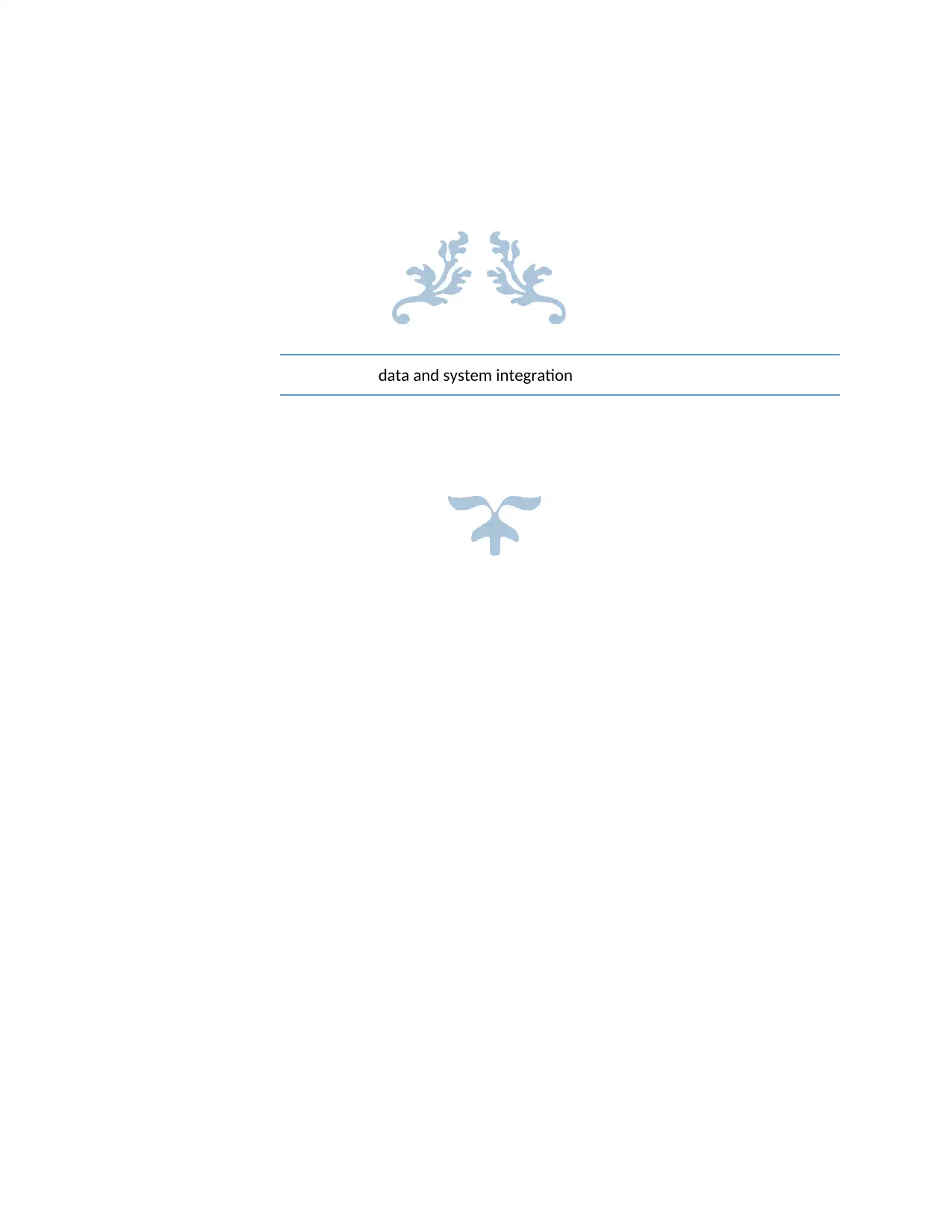
data and system integration
Paraphrase This Document
Need a fresh take? Get an instant paraphrase of this document with our AI Paraphraser
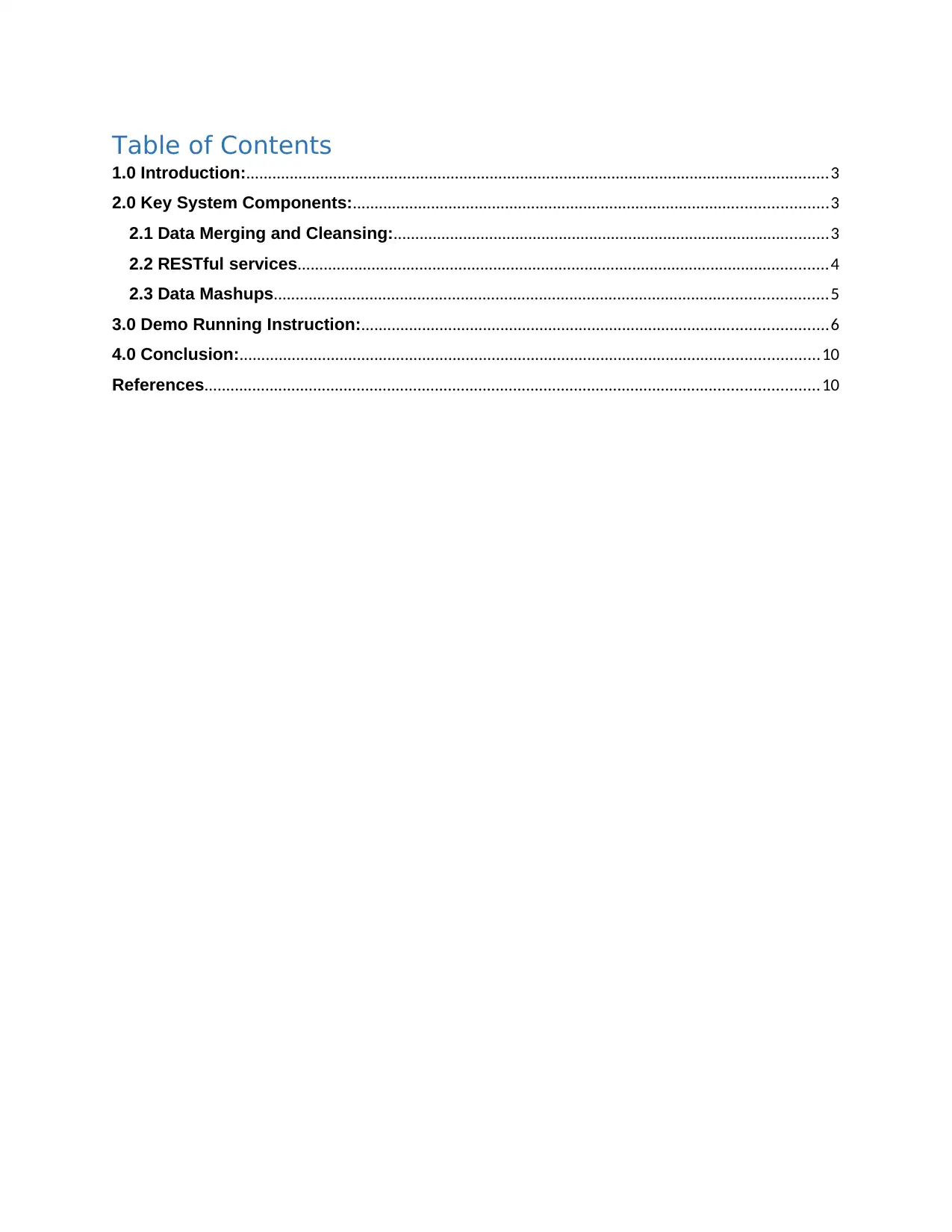
Table of Contents
1.0 Introduction:......................................................................................................................................3
2.0 Key System Components:.............................................................................................................3
2.1 Data Merging and Cleansing:....................................................................................................3
2.2 RESTful services..........................................................................................................................4
2.3 Data Mashups...............................................................................................................................5
3.0 Demo Running Instruction:...........................................................................................................6
4.0 Conclusion:.....................................................................................................................................10
References.............................................................................................................................................10
1.0 Introduction:......................................................................................................................................3
2.0 Key System Components:.............................................................................................................3
2.1 Data Merging and Cleansing:....................................................................................................3
2.2 RESTful services..........................................................................................................................4
2.3 Data Mashups...............................................................................................................................5
3.0 Demo Running Instruction:...........................................................................................................6
4.0 Conclusion:.....................................................................................................................................10
References.............................................................................................................................................10

Table of Figures
Figure 1 merging the xml and csv file.........................................................................................................7
Figure 2 Using Restful API for finding the Services.....................................................................................8
Figure 3 To use the Clinic id to find the location.......................................................................................8
Figure 4 easily find out the location of the clinic map using MapAPI........................................................9
Figure 1 merging the xml and csv file.........................................................................................................7
Figure 2 Using Restful API for finding the Services.....................................................................................8
Figure 3 To use the Clinic id to find the location.......................................................................................8
Figure 4 easily find out the location of the clinic map using MapAPI........................................................9
⊘ This is a preview!⊘
Do you want full access?
Subscribe today to unlock all pages.

Trusted by 1+ million students worldwide
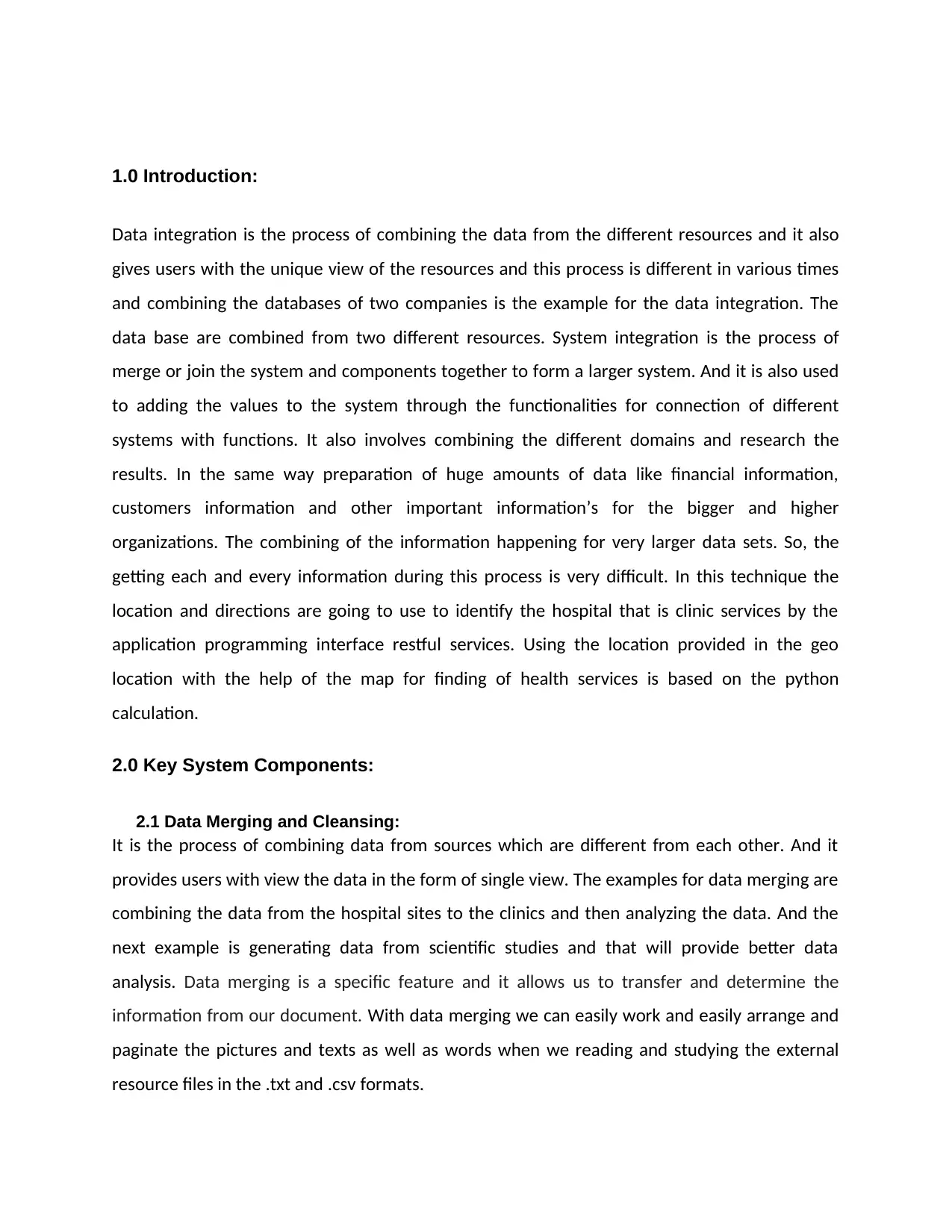
1.0 Introduction:
Data integration is the process of combining the data from the different resources and it also
gives users with the unique view of the resources and this process is different in various times
and combining the databases of two companies is the example for the data integration. The
data base are combined from two different resources. System integration is the process of
merge or join the system and components together to form a larger system. And it is also used
to adding the values to the system through the functionalities for connection of different
systems with functions. It also involves combining the different domains and research the
results. In the same way preparation of huge amounts of data like financial information,
customers information and other important information’s for the bigger and higher
organizations. The combining of the information happening for very larger data sets. So, the
getting each and every information during this process is very difficult. In this technique the
location and directions are going to use to identify the hospital that is clinic services by the
application programming interface restful services. Using the location provided in the geo
location with the help of the map for finding of health services is based on the python
calculation.
2.0 Key System Components:
2.1 Data Merging and Cleansing:
It is the process of combining data from sources which are different from each other. And it
provides users with view the data in the form of single view. The examples for data merging are
combining the data from the hospital sites to the clinics and then analyzing the data. And the
next example is generating data from scientific studies and that will provide better data
analysis. Data merging is a specific feature and it allows us to transfer and determine the
information from our document. With data merging we can easily work and easily arrange and
paginate the pictures and texts as well as words when we reading and studying the external
resource files in the .txt and .csv formats.
Data integration is the process of combining the data from the different resources and it also
gives users with the unique view of the resources and this process is different in various times
and combining the databases of two companies is the example for the data integration. The
data base are combined from two different resources. System integration is the process of
merge or join the system and components together to form a larger system. And it is also used
to adding the values to the system through the functionalities for connection of different
systems with functions. It also involves combining the different domains and research the
results. In the same way preparation of huge amounts of data like financial information,
customers information and other important information’s for the bigger and higher
organizations. The combining of the information happening for very larger data sets. So, the
getting each and every information during this process is very difficult. In this technique the
location and directions are going to use to identify the hospital that is clinic services by the
application programming interface restful services. Using the location provided in the geo
location with the help of the map for finding of health services is based on the python
calculation.
2.0 Key System Components:
2.1 Data Merging and Cleansing:
It is the process of combining data from sources which are different from each other. And it
provides users with view the data in the form of single view. The examples for data merging are
combining the data from the hospital sites to the clinics and then analyzing the data. And the
next example is generating data from scientific studies and that will provide better data
analysis. Data merging is a specific feature and it allows us to transfer and determine the
information from our document. With data merging we can easily work and easily arrange and
paginate the pictures and texts as well as words when we reading and studying the external
resource files in the .txt and .csv formats.
Paraphrase This Document
Need a fresh take? Get an instant paraphrase of this document with our AI Paraphraser
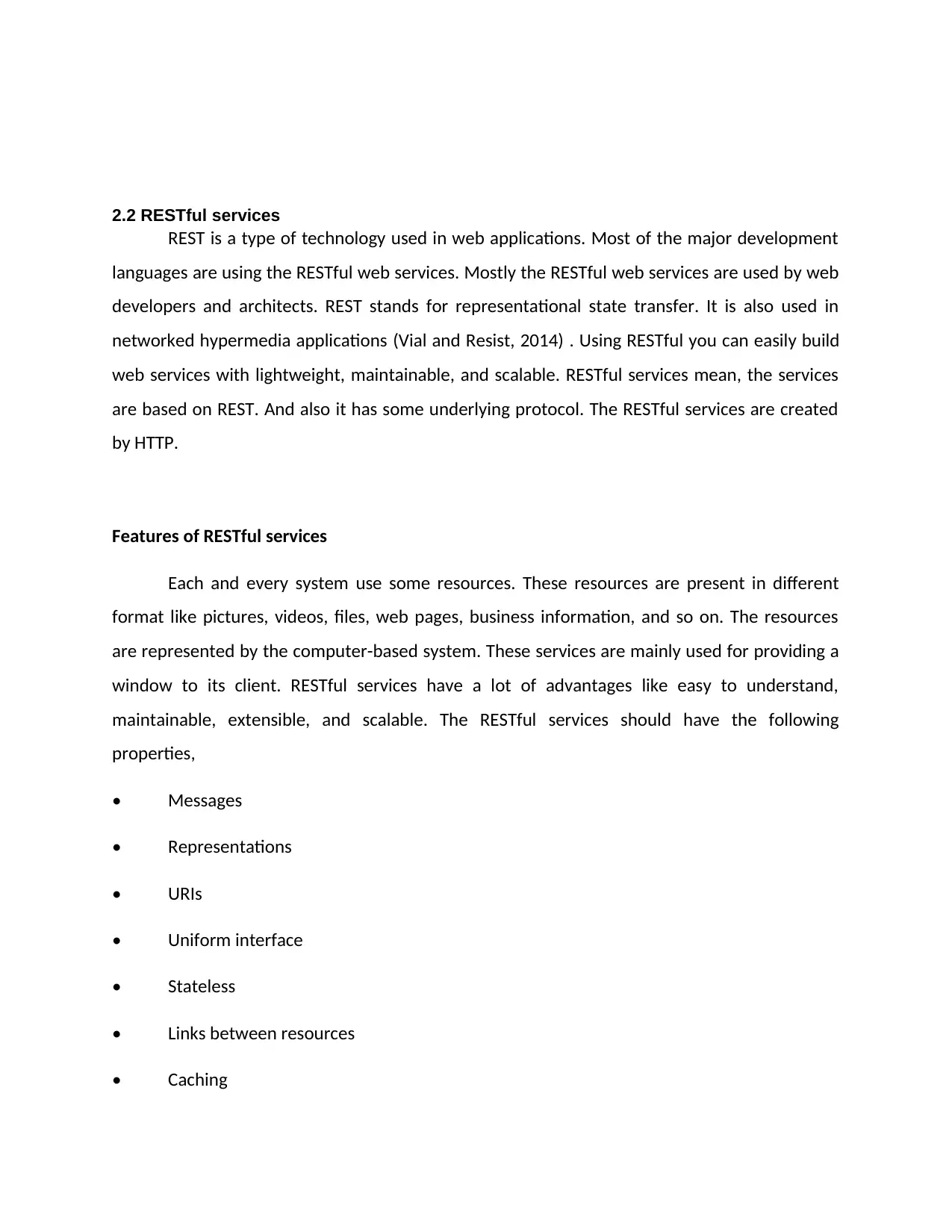
2.2 RESTful services
REST is a type of technology used in web applications. Most of the major development
languages are using the RESTful web services. Mostly the RESTful web services are used by web
developers and architects. REST stands for representational state transfer. It is also used in
networked hypermedia applications (Vial and Resist, 2014) . Using RESTful you can easily build
web services with lightweight, maintainable, and scalable. RESTful services mean, the services
are based on REST. And also it has some underlying protocol. The RESTful services are created
by HTTP.
Features of RESTful services
Each and every system use some resources. These resources are present in different
format like pictures, videos, files, web pages, business information, and so on. The resources
are represented by the computer-based system. These services are mainly used for providing a
window to its client. RESTful services have a lot of advantages like easy to understand,
maintainable, extensible, and scalable. The RESTful services should have the following
properties,
• Messages
• Representations
• URIs
• Uniform interface
• Stateless
• Links between resources
• Caching
REST is a type of technology used in web applications. Most of the major development
languages are using the RESTful web services. Mostly the RESTful web services are used by web
developers and architects. REST stands for representational state transfer. It is also used in
networked hypermedia applications (Vial and Resist, 2014) . Using RESTful you can easily build
web services with lightweight, maintainable, and scalable. RESTful services mean, the services
are based on REST. And also it has some underlying protocol. The RESTful services are created
by HTTP.
Features of RESTful services
Each and every system use some resources. These resources are present in different
format like pictures, videos, files, web pages, business information, and so on. The resources
are represented by the computer-based system. These services are mainly used for providing a
window to its client. RESTful services have a lot of advantages like easy to understand,
maintainable, extensible, and scalable. The RESTful services should have the following
properties,
• Messages
• Representations
• URIs
• Uniform interface
• Stateless
• Links between resources
• Caching
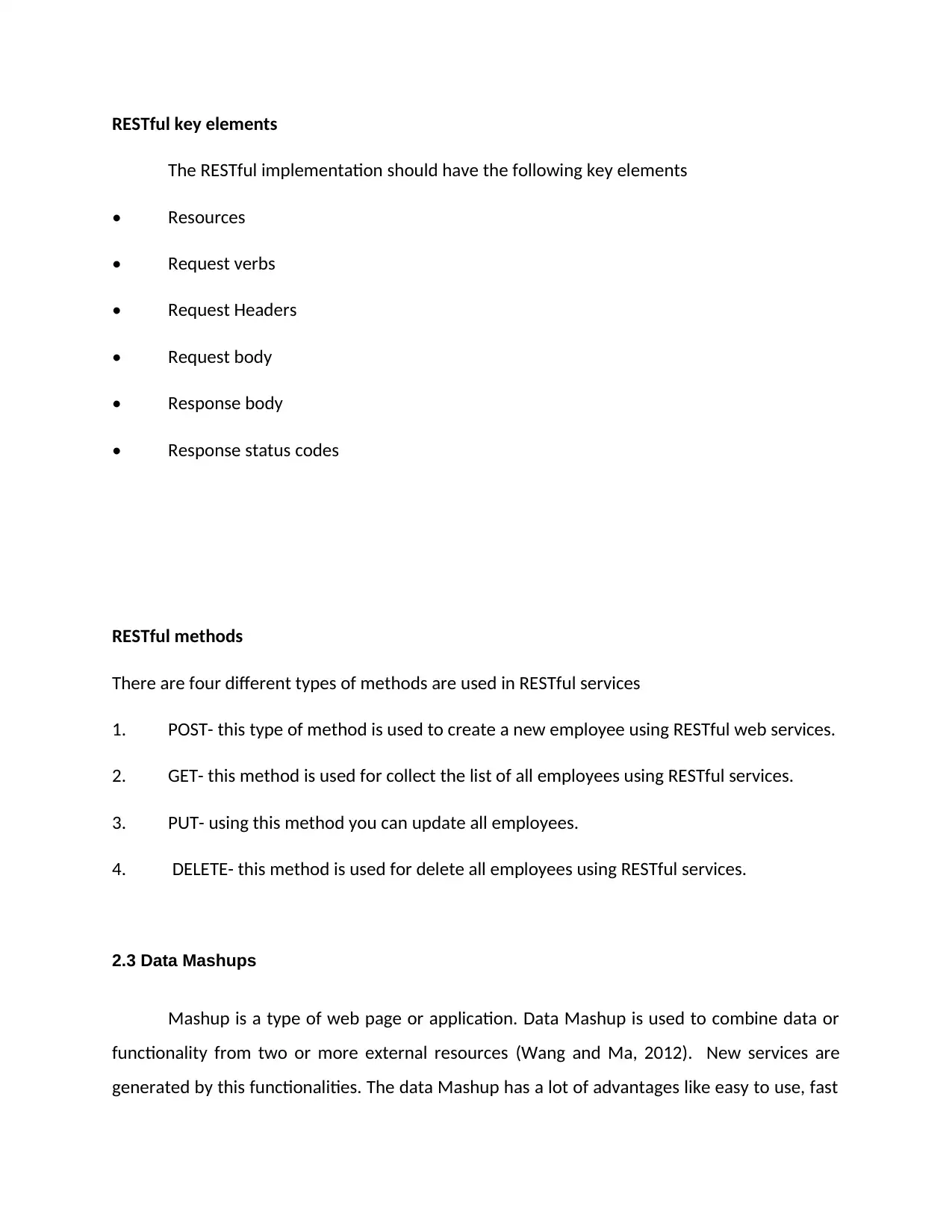
RESTful key elements
The RESTful implementation should have the following key elements
• Resources
• Request verbs
• Request Headers
• Request body
• Response body
• Response status codes
RESTful methods
There are four different types of methods are used in RESTful services
1. POST- this type of method is used to create a new employee using RESTful web services.
2. GET- this method is used for collect the list of all employees using RESTful services.
3. PUT- using this method you can update all employees.
4. DELETE- this method is used for delete all employees using RESTful services.
2.3 Data Mashups
Mashup is a type of web page or application. Data Mashup is used to combine data or
functionality from two or more external resources (Wang and Ma, 2012). New services are
generated by this functionalities. The data Mashup has a lot of advantages like easy to use, fast
The RESTful implementation should have the following key elements
• Resources
• Request verbs
• Request Headers
• Request body
• Response body
• Response status codes
RESTful methods
There are four different types of methods are used in RESTful services
1. POST- this type of method is used to create a new employee using RESTful web services.
2. GET- this method is used for collect the list of all employees using RESTful services.
3. PUT- using this method you can update all employees.
4. DELETE- this method is used for delete all employees using RESTful services.
2.3 Data Mashups
Mashup is a type of web page or application. Data Mashup is used to combine data or
functionality from two or more external resources (Wang and Ma, 2012). New services are
generated by this functionalities. The data Mashup has a lot of advantages like easy to use, fast
⊘ This is a preview!⊘
Do you want full access?
Subscribe today to unlock all pages.

Trusted by 1+ million students worldwide
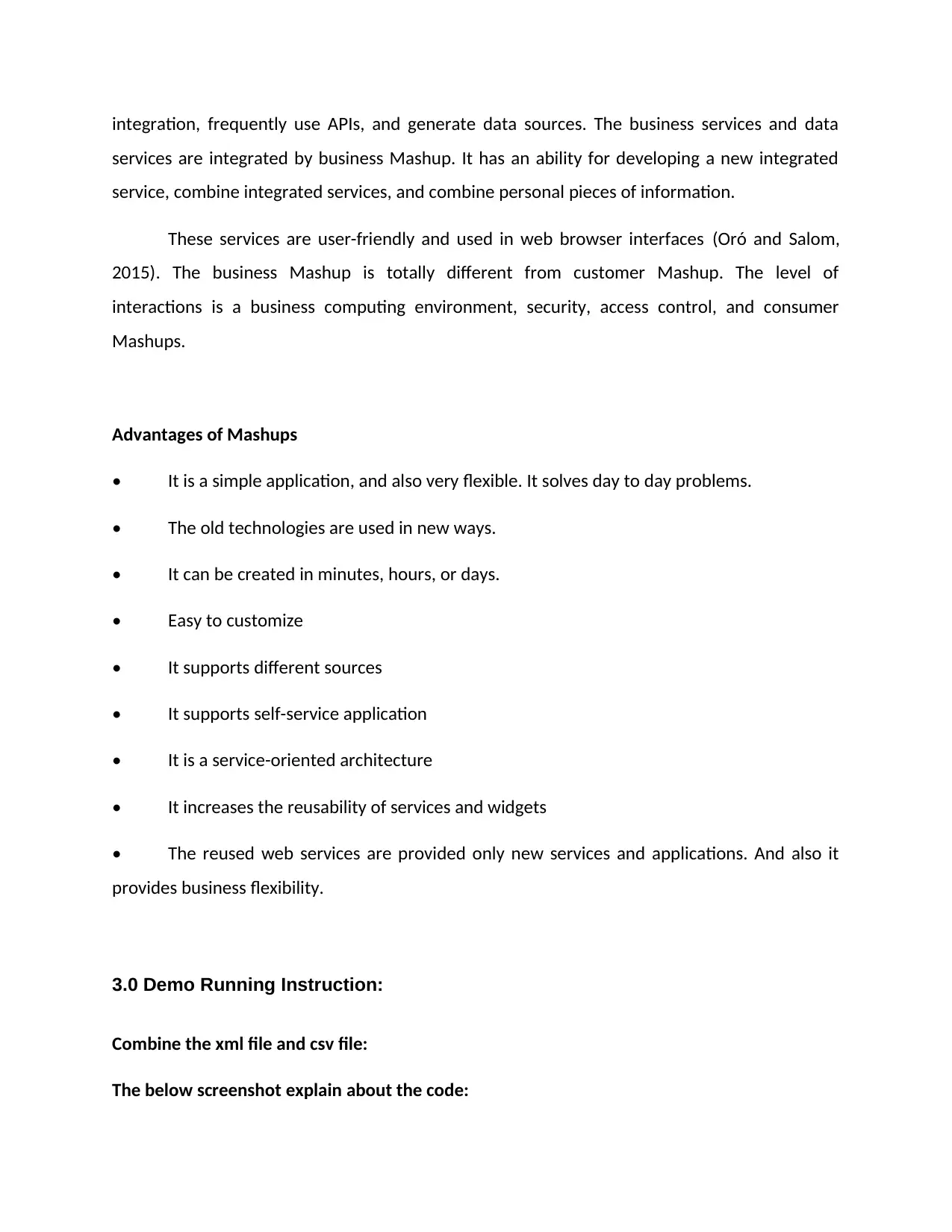
integration, frequently use APIs, and generate data sources. The business services and data
services are integrated by business Mashup. It has an ability for developing a new integrated
service, combine integrated services, and combine personal pieces of information.
These services are user-friendly and used in web browser interfaces (Oró and Salom,
2015). The business Mashup is totally different from customer Mashup. The level of
interactions is a business computing environment, security, access control, and consumer
Mashups.
Advantages of Mashups
• It is a simple application, and also very flexible. It solves day to day problems.
• The old technologies are used in new ways.
• It can be created in minutes, hours, or days.
• Easy to customize
• It supports different sources
• It supports self-service application
• It is a service-oriented architecture
• It increases the reusability of services and widgets
• The reused web services are provided only new services and applications. And also it
provides business flexibility.
3.0 Demo Running Instruction:
Combine the xml file and csv file:
The below screenshot explain about the code:
services are integrated by business Mashup. It has an ability for developing a new integrated
service, combine integrated services, and combine personal pieces of information.
These services are user-friendly and used in web browser interfaces (Oró and Salom,
2015). The business Mashup is totally different from customer Mashup. The level of
interactions is a business computing environment, security, access control, and consumer
Mashups.
Advantages of Mashups
• It is a simple application, and also very flexible. It solves day to day problems.
• The old technologies are used in new ways.
• It can be created in minutes, hours, or days.
• Easy to customize
• It supports different sources
• It supports self-service application
• It is a service-oriented architecture
• It increases the reusability of services and widgets
• The reused web services are provided only new services and applications. And also it
provides business flexibility.
3.0 Demo Running Instruction:
Combine the xml file and csv file:
The below screenshot explain about the code:
Paraphrase This Document
Need a fresh take? Get an instant paraphrase of this document with our AI Paraphraser
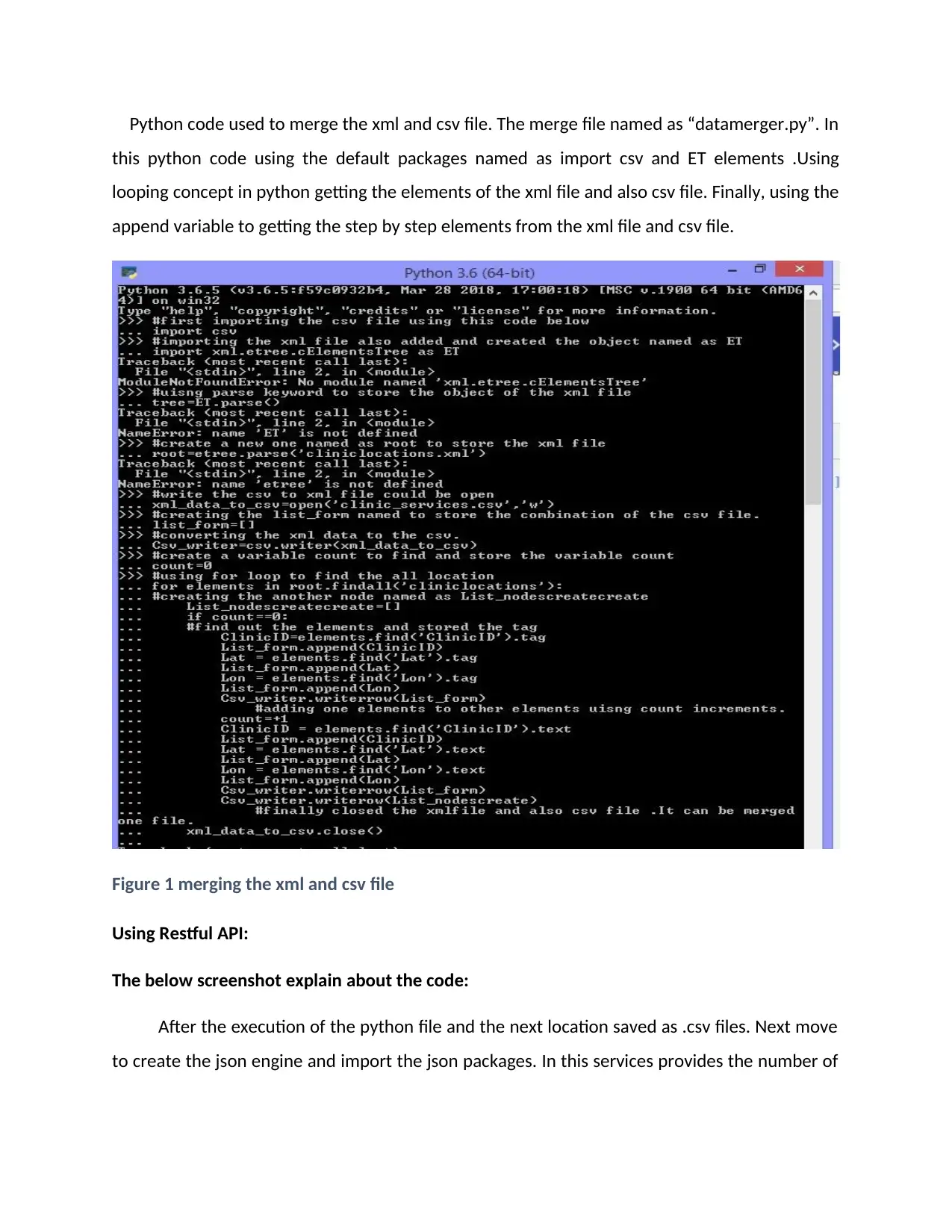
Python code used to merge the xml and csv file. The merge file named as “datamerger.py”. In
this python code using the default packages named as import csv and ET elements .Using
looping concept in python getting the elements of the xml file and also csv file. Finally, using the
append variable to getting the step by step elements from the xml file and csv file.
Figure 1 merging the xml and csv file
Using Restful API:
The below screenshot explain about the code:
After the execution of the python file and the next location saved as .csv files. Next move
to create the json engine and import the json packages. In this services provides the number of
this python code using the default packages named as import csv and ET elements .Using
looping concept in python getting the elements of the xml file and also csv file. Finally, using the
append variable to getting the step by step elements from the xml file and csv file.
Figure 1 merging the xml and csv file
Using Restful API:
The below screenshot explain about the code:
After the execution of the python file and the next location saved as .csv files. Next move
to create the json engine and import the json packages. In this services provides the number of
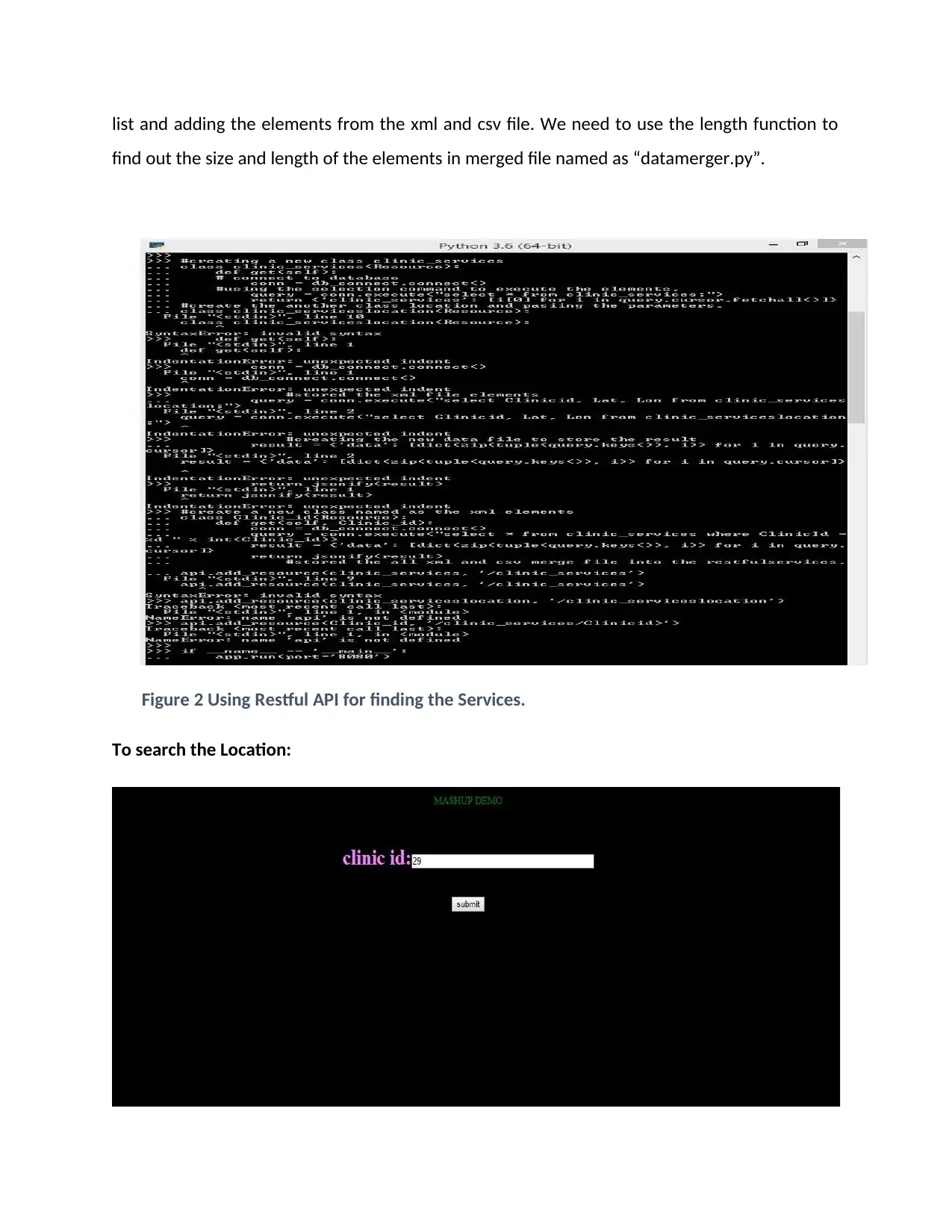
list and adding the elements from the xml and csv file. We need to use the length function to
find out the size and length of the elements in merged file named as “datamerger.py”.
Figure 2 Using Restful API for finding the Services.
To search the Location:
find out the size and length of the elements in merged file named as “datamerger.py”.
Figure 2 Using Restful API for finding the Services.
To search the Location:
⊘ This is a preview!⊘
Do you want full access?
Subscribe today to unlock all pages.

Trusted by 1+ million students worldwide
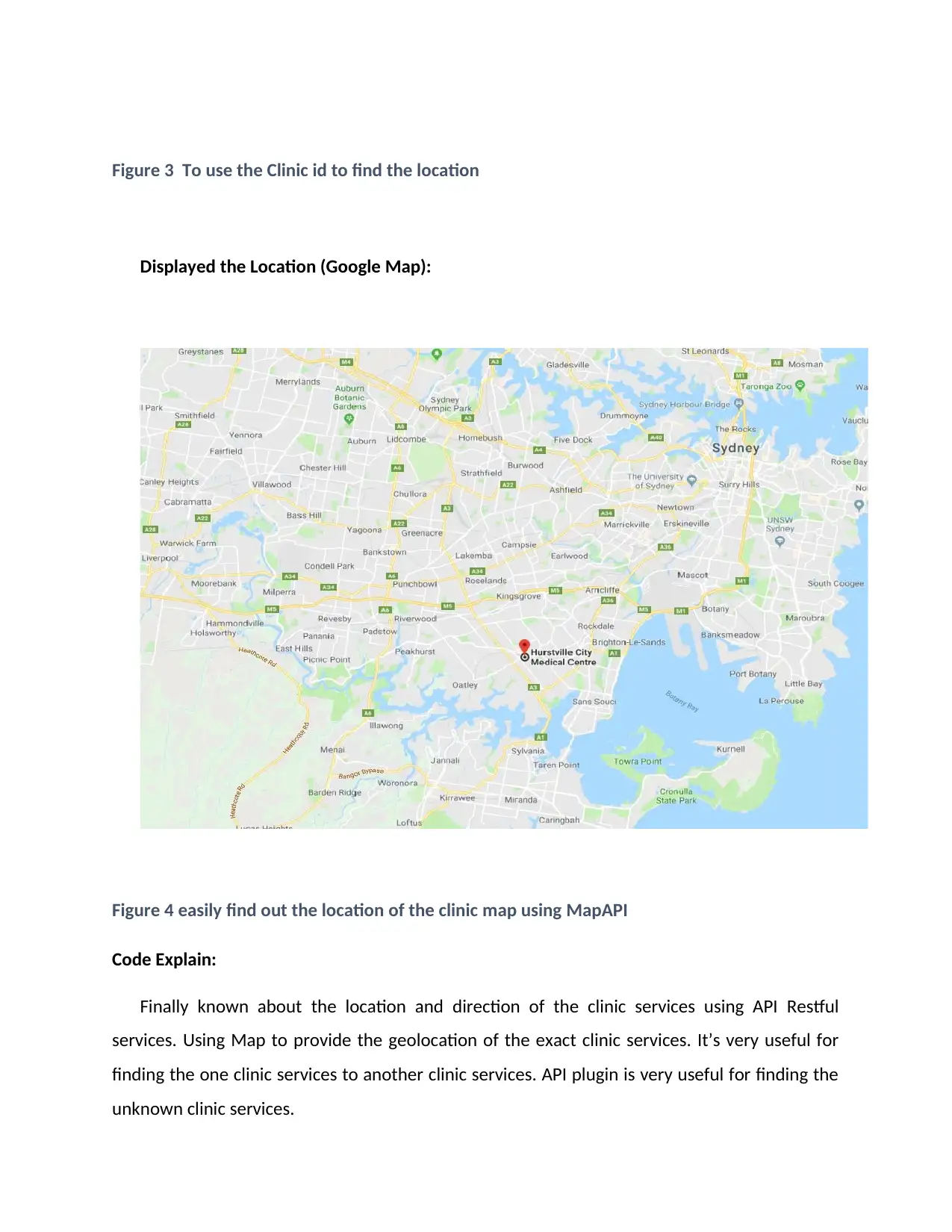
Figure 3 To use the Clinic id to find the location
Displayed the Location (Google Map):
Figure 4 easily find out the location of the clinic map using MapAPI
Code Explain:
Finally known about the location and direction of the clinic services using API Restful
services. Using Map to provide the geolocation of the exact clinic services. It’s very useful for
finding the one clinic services to another clinic services. API plugin is very useful for finding the
unknown clinic services.
Displayed the Location (Google Map):
Figure 4 easily find out the location of the clinic map using MapAPI
Code Explain:
Finally known about the location and direction of the clinic services using API Restful
services. Using Map to provide the geolocation of the exact clinic services. It’s very useful for
finding the one clinic services to another clinic services. API plugin is very useful for finding the
unknown clinic services.
Paraphrase This Document
Need a fresh take? Get an instant paraphrase of this document with our AI Paraphraser
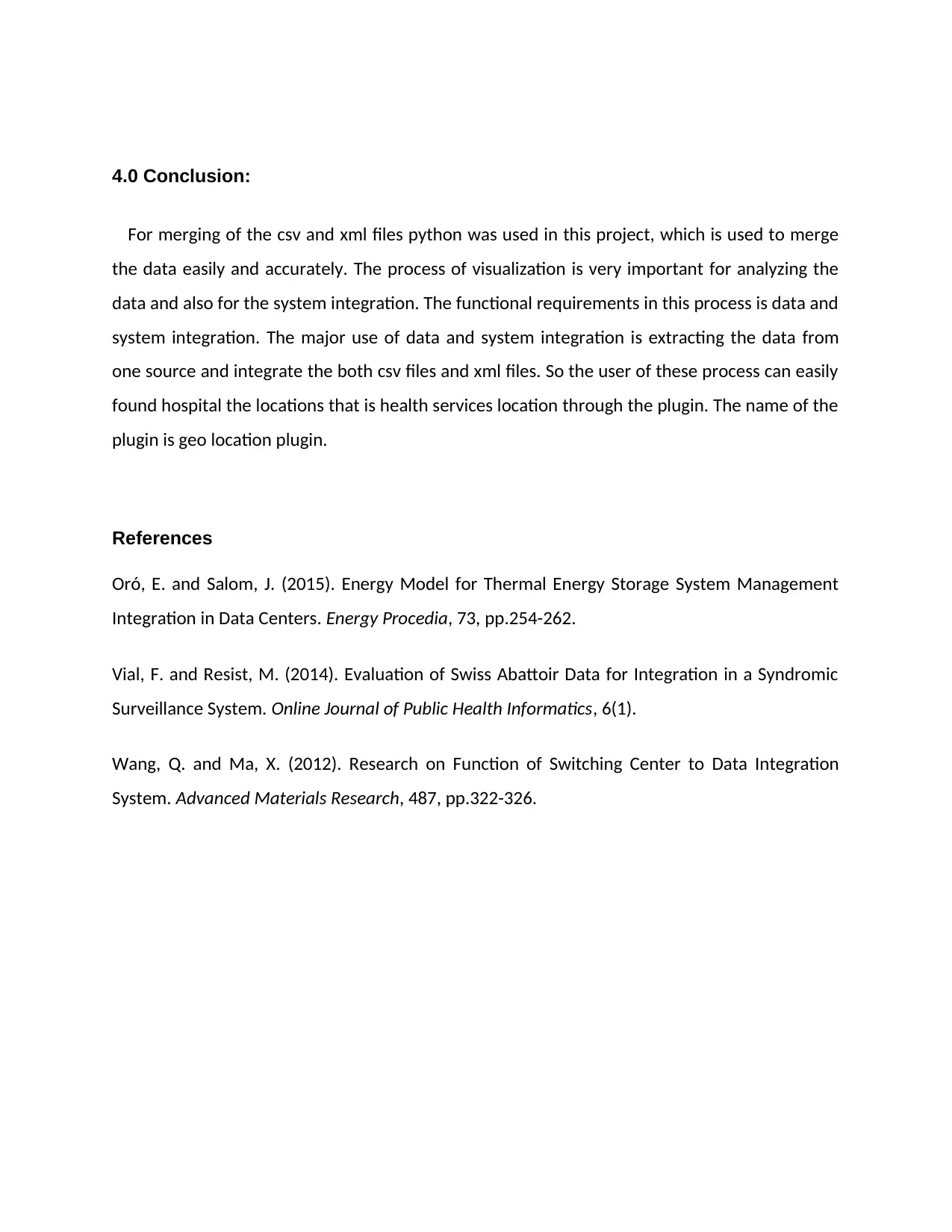
4.0 Conclusion:
For merging of the csv and xml files python was used in this project, which is used to merge
the data easily and accurately. The process of visualization is very important for analyzing the
data and also for the system integration. The functional requirements in this process is data and
system integration. The major use of data and system integration is extracting the data from
one source and integrate the both csv files and xml files. So the user of these process can easily
found hospital the locations that is health services location through the plugin. The name of the
plugin is geo location plugin.
References
Oró, E. and Salom, J. (2015). Energy Model for Thermal Energy Storage System Management
Integration in Data Centers. Energy Procedia, 73, pp.254-262.
Vial, F. and Resist, M. (2014). Evaluation of Swiss Abattoir Data for Integration in a Syndromic
Surveillance System. Online Journal of Public Health Informatics, 6(1).
Wang, Q. and Ma, X. (2012). Research on Function of Switching Center to Data Integration
System. Advanced Materials Research, 487, pp.322-326.
For merging of the csv and xml files python was used in this project, which is used to merge
the data easily and accurately. The process of visualization is very important for analyzing the
data and also for the system integration. The functional requirements in this process is data and
system integration. The major use of data and system integration is extracting the data from
one source and integrate the both csv files and xml files. So the user of these process can easily
found hospital the locations that is health services location through the plugin. The name of the
plugin is geo location plugin.
References
Oró, E. and Salom, J. (2015). Energy Model for Thermal Energy Storage System Management
Integration in Data Centers. Energy Procedia, 73, pp.254-262.
Vial, F. and Resist, M. (2014). Evaluation of Swiss Abattoir Data for Integration in a Syndromic
Surveillance System. Online Journal of Public Health Informatics, 6(1).
Wang, Q. and Ma, X. (2012). Research on Function of Switching Center to Data Integration
System. Advanced Materials Research, 487, pp.322-326.
1 out of 11
Related Documents
Your All-in-One AI-Powered Toolkit for Academic Success.
+13062052269
info@desklib.com
Available 24*7 on WhatsApp / Email
![[object Object]](/_next/static/media/star-bottom.7253800d.svg)
Unlock your academic potential
Copyright © 2020–2025 A2Z Services. All Rights Reserved. Developed and managed by ZUCOL.




